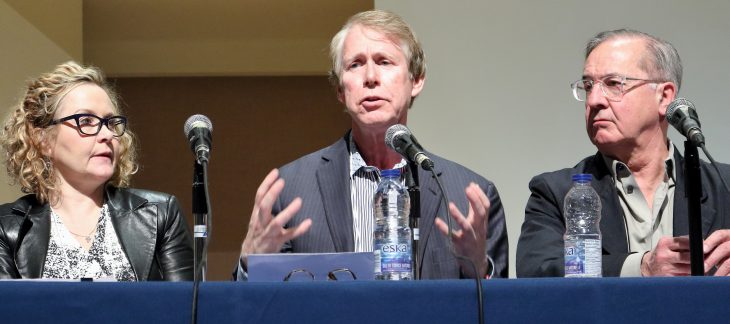
TORONTO – The Canadian film, television and print production industry “is in a death spiral” that only government action can halt, several experts agreed at a digital media conference held Saturday in Toronto.
The former Harper government, current Heritage Minister Mélanie Joly, the CRTC and private broadcasters came in for heated criticism for failing to give content producers the tools to fight the falling advertising which print publications have been seeing – and the flight of viewers from conventional television to Netflix, Facebook, Google and others.
There were no shortage of solutions offered, but speakers on a film and TV panel did seem warmest to the recommendation of long time TV executive Richard Stursberg. The former EVP of the CBC English network and current president of PEN Canada, said those he called “foreign digital broadcasters” (including Netflix, Facebook and any other non-Canadian content provider such as Disney’s planned 2019 OTT service and CBS All Access, which is coming to Canada this year) should be forced to put 30% of their gross revenues into content production here.
“That’s not unreasonable number and is clearly consistent with what we have here and consistent with where the Europeans are going,” he said.
In addition, the Broadcasting Act should be changed to define Canadian film or TV to give the most credit for Canadian plots and actors and ignoring whether the production company is Canadian owned.
But it was the no-holds barred comments from Stephen Stohn, executive producer of the Degrassi teen TV series and winner of several Canadian Screen Awards, that set the conference alight. “In Canada the death clock has been moved forward by one institution. Tragically, ironically, that institution is the CRTC.” Stohn told the fourth annual Digital Media at the Crossroads conference.
“Why did the CRTC abdicate its responsibility to guard the industry?” – Stephen Stohn, Degrassi
The regulator has stayed away from touching over-the-top streaming services like Netflix, “which I will suggest will come in and completely swamp the Canadian system. It’s almost inevitable,” he said. “Why did the CRTC abdicate its responsibility to guard the industry?”
He said he was told privately it was because Commission leaders at the time wanted to let the “free-market” prevail. But Stohn said, there is no free market in Canada in broadcasting, only “oligopolies.” Regulation is the answer, he said, but said that to justify government intervention the industry will have to persuade the public it’s a matter of jobs, not Canadian culture. At the same time, the industry has to more clearly define a Canadian program. Part of the answer may be in defining what “Canadian” is by what we are not,” he said.
“What we are not is Donald Trump and everything that America now seems to be modelling. The narcissistic bullying, exploitation of people and the aggrandismo of superficial good looks and power and bullying. Those are all completely at the other end of the spectrum from what most Canadians would aspire to… We don’t just want to tell Canadian stories but really what our mission may really be is to save ourselves and our children from the Americanization of our county.”
There was loud applause.
Stursberg also complained Minister Joly had “nothing to say of any use whatsoever on the ongoing crisis of the broadcasters and the news business,” when she released the government’s Creative Canada policy in September, 2017.
“The anxiety I have … is we’re acting as if we can get there on the back of a snail.” – Doug Barrett, Schulich School of Business
Doug Barrett, adjunct professor in the arts media and entertainment management program at York University’s Schulich School of Business, said after releasing the new policy the Liberals have shown “a complete lack of urgency” on cultural problems created by online content. Instead “they’ve punted this to CRTC for hearings.” Will the government want to update the Broadcasting Act in 2019, when a federal election is expected, he asked. “The anxiety I have … is we’re acting as if we can get there on the back of a snail.”
“What the hell are we doing dicking around with all these hearings and consultations? Can’t we just get on with defining the problem and fixing the issue?”
Maureen Parker, executive director of the Writers Guild of Canada, which represents screenwriters, blamed the government of former Prime Minster Stephen Harper for putting the CRTC behind the eight-ball, noting he campaigned on a promise Netflix wouldn’t be taxed.
However, she praised the current Liberal cabinet for overturning a CRTC decision that would have cut the percentage of revenue that broadcasters Corus Entertainment and Bell Media would have had to contribute to programs of national interest, including drama. That do-over is not yet complete.
On the other hand Parker also complained private broadcasters never step forward and say they want to make Canadian programs. When they do “it’s always been like pulling teeth.”
When it came to other solutions, panelists suggested a focused tax on Internet service providers for carrying digital content, making OTT players pay HST and overhauling the Broadcasting Act (Ed note: The current federal government has shot down the first two and says it’s going to do the third, but has not acted yet).
In an interview after the panel, moderator James Nadler, chair of Ryerson University’s school of creative industries, agreed with Parker that the industry has to get the public approval for some of the solutions “and raise the discussion from ‘This is going to raise my cable bill,’ to ‘I want to see shows that reflect my world, my values.”
Photo of, from left, Maureen Parker, Stephen Stohn, Richard Stursberg by Howard Solomon.



